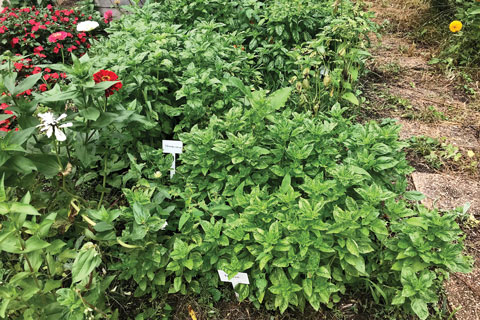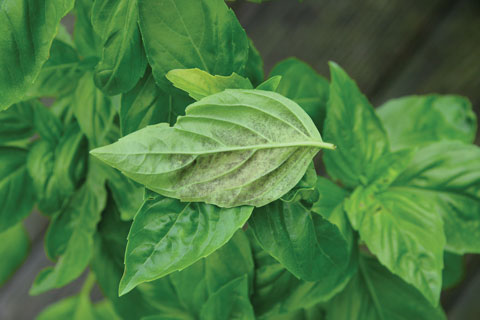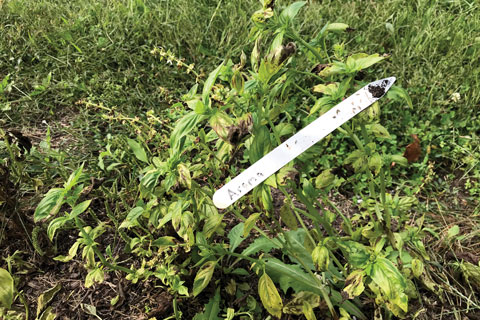5/1/2022
Trialing Basil for Disease
Stanton Gill, David Clement, Jerry Brust & Karen Rane

Downy mildew continues to be the biggest challenge to basil production in America. The disease, Peronospora belbahrii, was first reported in Africa in 1934. The first U.S. report occurred in South Florida in October 2007. Within five years, the disease spread throughout the U.S. and is found wherever basil is grown.
The disease can decimate a basil crop, usually in late summer to early fall, ending the plant’s life rapidly. The best defense against this disease is the use of basil cultivars that are resistant to downy mildew. Italian sweet basil, which is the most popular for use in culinary dishes and a popular CEA crop, is highly susceptible to this disease.
Pictured: Thunderstruck and Passion basil plants during the trials.
Photo by Stanton Gill.
For the last three years, our team at the University of Maryland Extension has been testing cultivars that were bred for resistance to downy mildew. Rutgers University has released the cultivars Devotion, Obsession, Passion and Thunderstruck, which are reported to have good resistance. A promising resistant basil cultivar, Prospera, has been developed by researchers at Genesis Seeds in Israel.
The trial locations
Weather varies from location to location and influences the disease pressure in a given year. We expanded our testing sites to three different parts of Maryland, each with different temperature and humidity levels. We selected sites in north-central Maryland, (Westminster and Finksburg), central Maryland (Central Maryland Research and Education Center [CMREC], and Brookeville) and southern Maryland (CMREC-UMF) with each site having different light and air circulation.
Warm, humid conditions at a site greatly influence the disease pressure; this will vary from site to site. The site in Westminster was at the top of a field in an open airy space. The sites at CMREC and Brookeville were in areas with 10 hours of direct sunlight, but surrounded by plant material that reduced air circulation. The length of direct sunlight reduced to eight hours for both sites by September. These two central Maryland sites were more typical of urban garden plots.
The site in southern Maryland was located a few miles north of Upper Marlboro at the CMREC-UMF facility and was in sunlight throughout the day with no reduced air circulation. The plants in Finksburg were in a full-sun location.
Trial details
The basils were started from seed in a commercial greenhouse operation (special thanks to Hillcrest Nursery in Millers, Maryland, for starting the seeds for these trials). All the plants were established in the growing plots at the five sites in 2021 in the first week of June. We took data on the number of times we could harvest the basil plants in the summer and fall at the Brookeville and Westminster sites, as well as the Upper Marlboro site. We waited until plants were 20-in. to 24-in. before each harvest. The foliage was examined and symptoms of downy mildew noted on a 14-day interval.
 The Westminster, CMREC, Finksburg and Brookeville sites were established on June 24. At the Westminster and Brookeville sites, the basil plants were planted in raised beds made up of 8% leaf compost and a trickle irrigation system with T-tape was established shortly after transplant. There were 10 reps of each cultivar with six individual plants of each cultivar. Obsession, Passion, Devotion, Thunderstruck, Aroma, Prospera, Dark Opal and lemon basil were established at these two sites.
The Westminster, CMREC, Finksburg and Brookeville sites were established on June 24. At the Westminster and Brookeville sites, the basil plants were planted in raised beds made up of 8% leaf compost and a trickle irrigation system with T-tape was established shortly after transplant. There were 10 reps of each cultivar with six individual plants of each cultivar. Obsession, Passion, Devotion, Thunderstruck, Aroma, Prospera, Dark Opal and lemon basil were established at these two sites.
Pictured: Downy mildew is shown on the underside of an Aroma basil leaf. Photo by Dave Clement.
At the CMREC site, the plants were placed in topsoil with 2% organic material. No trickle irrigation was established at this site. Space was limited, so we planted four reps of each cultivar with two individual plants per cultivar in each rep. Obsession, Passion, Devotion, Thunderstruck, Aroma and Prospera were transplanted to this site. At the Finksburg site, plants of Prospera, Devotion, Thunderstruck and Aroma were established and grown in containers under full-sun conditions.
For the Upper Marlboro site, seedlings of Obsession, Passion, Devotion, Thunderstruck, Aroma and Prospera were transplanted on July 21. The transplants were planted into two rows of white plastic with drip irrigation. There were four reps of each cultivar with six plants per rep. First harvest occurred on August 4 for all cultivars except Obsession.
Harvest consisted of taking the top part of a plant and cutting it down to within 4-in. to 8-in. of the soil. The harvested basil was examined for quality and recorded as marketable weight per plant. Harvests occurred approximately every two weeks (August 4, 17, 31; September 15, 28; and October 15).
Trial evaluation
Westminster & Brookeville
For the Westminster and Brookeville sites, harvest was every two weeks in July, August and mid-September, cutting stems to 4-in. of the soil line. Bunches varied from four to seven stems per plant at each harvest. At farm markets these bunches could easily fetch $5 to $6/bunch.
The first harvest occurred July 15 and continued at two-week intervals though mid-September. In mid-September, as temperatures became cooler, harvest was extended to every four weeks. By early October the cultivars Devotion, Obsession, Prospera, Passion and Thunderstruck all started to produce flowers, while Amazel Basil started to produce seed heads by late August; the plants stopped producing marketable foliage by early September.
At the Westminster site, downy mildew was detected on September 18 on Aroma Basil with 30% of foliage infected. By October 5, all of the Aroma plants were dead. Passion had 10% of the foliage infected with downy mildew on September 18, but the plants continued to grow and produce foliage. By the October observation date, over 50% of foliage had necrotic spots from the downy mildew, making it unmarketable.
At the Brookeville site, on September 18 we detected downy mildew on Aroma, lemon basil and Passion Basil plants. The Aroma and lemon basil plants were thoroughly covered in downy mildew within two weeks. The Passion basil showed 20% to 30% of the foliage infected; though the plants continued to grow, they didn’t have marketable foliage. Prospera, Obsession, Devotion, Thunderstruck and Dark Opal all were free of downy mildew until heavy frost in early November ended the trial.
Finksburg & CMREC
On August 6, the first downy mildew infections were seen on Aroma at the Finksburg and CMREC sites. The first symptoms of infection were recorded on Devotion at Finksburg on August 16. By August 21, we found downy mildew had encompassed 50% of the foliage on the Aroma plants at both sites. By September 29, the Aroma foliage was 100% infected with downy mildew at both sites.
Symptoms on Devotion increased to about 50% of the foliage by mid-September. No evidence of Fusarium wilt was seen and no downy mildew symptoms were detected on Prospera, Passion, Obsession or Thunderstruck at the CMREC or Finksburg sites.
The CMREC plants were not as vigorous and were first harvested mid-August with second harvest at the end of September. The reduced vigor is likely due to the poorer soil quality, low organic content in the soil and lack of an irrigation system.
CMREC-UMF
At the Upper Marlboro farm site, no symptoms of downy mildew were observed on any basil cultivar during the first harvest (August 4). Second harvest (August 17) showed the cultivars Passion, Devotion and Aroma yielded well, with Passion having significantly greater (p<0.05) marketable yields than Prospera and Obsession. Fusarium wilt of basil was found on a few plants of Thunderstruck at this time. No downy mildew was found on any cultivar on this harvest date or the third harvest date (August 31).
 Pictured: Aroma Basil on October 9—highly susceptible to downy mildew.
Pictured: Aroma Basil on October 9—highly susceptible to downy mildew.
Photo by Stanton Gill.
On the fourth harvest (September 15), downy mildew was found on Passion, Obsession, Devotion, Thunderstruck and Aroma, but not on Prospera. Marketable yields were reduced significantly (p<0.05) by 55% for Passion, Obsession, Devotion and Thunderstruck compared with Prospera. The susceptible cultivar Aroma had its marketable yield reduced by 95% compared with Prospera and by 85% when compared with Passion, Obsession, Devotion and Thunderstruck. By the fifth harvest (September 28), only Prospera had any marketable yields. Prospera showed no symptoms of basil downy mildew. The cultivar Aroma was defoliated on this harvest date and while the other cultivars still retained much of their foliage, that foliage had basil downy mildew infection, making them unmarketable.
Overall results
At the Westminster and Brookville sites, the basil cultivars Prospera, Obsession and Dark Opal over the last three years of trials have performed the best with production of cuttable stems and resistance to downy mildew. Thunderstruck was added to our trials in 2021 and performed well at the Brookeville, CMREC, Finksburg and Westminster sites. Devotion showed moderate downy mildew symptoms at the CMREC and Finksburg sites. The Aroma and lemon basil did well in the early to mid-part of the summer, but succumbed to downy mildew by late summer and continued into the fall with infection and death of plants. The basil Dark Opal was not as productive as the green leaf cultivars, but it also didn’t show any damage from downy mildew.
For the Upper Marlboro site in 2021, four of the five cultivars (Passion, Obsession, Devotion and Thunderstruck) became infected with downy mildew at the same time, as did the susceptible cultivar Aroma. At this study site, only Prospera didn’t develop downy mildew symptoms. The infected cultivars had significantly reduced marketable yields at first and then no marketable yields four weeks after infection. Prospera continued to have good marketable yields throughout the entire study period.
We’ll continue these trials in 2022 and add any new downy mildew-resistant cultivars that come onto the market. In 2022, we’ll add Emerald Towers to our trial. It’s showcased to be resistant to downy mildew and Fusarium. This cultivar is also touted to produce flowers until very late in the season, providing more useful foliage.
Basil Downy Mildew Fast Facts
• Basil downy mildew, specific to this crop, can spread rapidly and result in complete yield loss.
• Infection starts on lower leaves and moves up the plant.
• The pathogen that causes basil downy mildew can be transmitted on seed, transplants or fresh harvested product.
• The downy mildew pathogen doesn’t overwinter outdoors in most northern climates. Initial infections in northern locations can start from wind-blown spores moving northward from southern overwintering sites.
Stanton Gill is an Extension Specialist in IPM and Entomology; David Clement is an Extension Specialist in Plant Pathology; Jerry Brust is an Extension Specialist in Commercial Vegetable Production; and Karen Rane is Director of the University of Maryland Plant Clinic at University of Maryland Extension.